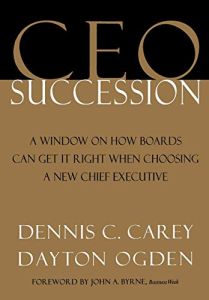Join getAbstract to access the summary!

Join getAbstract to access the summary!
Dennis C. Carey and Dayton Ogden
CEO Succession
A Window on How Boards Can Get It Right When Choosing a New Chief Executive
Oxford UP, 2000
What's inside?
The average CEO lasts seven years. What are you going to do when your Number One’s time is up?
Recommendation
Authors Dennis C. Carey and Dayton Ogden present a thorough, insightful guide to choosing a new Chief Executive Officer in this nicely written, concise book. Offering plenty of inside information and real-life corporate examples, the authors explore their ideas without resorting to fluff or to the dry, dull prose that often fills such books. Given their experience helping corporations choose CEOs and other executives, the authors know what they’re talking about and understand the tricky issues involved in putting any advice into practice. Their book delivers what it promises, and given that it can be repetitive, it delivers on some of those promises two or three times (but we’re quibbling, some of those lessons do bear repeating). GetAbstract recommends this book to anyone involved in executive succession and recruitment, especially board members (read it now, before you ditch your CEO, not after).
Summary
About the Authors
Dennis C. Carey specializes in the recruitment of CEOs and corporate directors for major U.S. corporations. He is Vice Chairman of Spencer Stuart, a global executive search firm. He is a co-founder of the Director’s Institute at the Wharton School, University of Pennsylvania. Dayton Ogden is co-chairman of Spencer Stuart and has previously served as the firm’s CEO and Chairman of the Strategy Committee.




















Comment on this summary